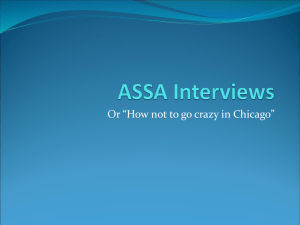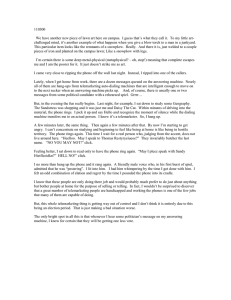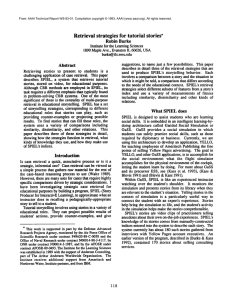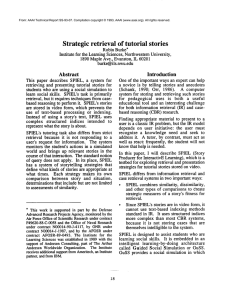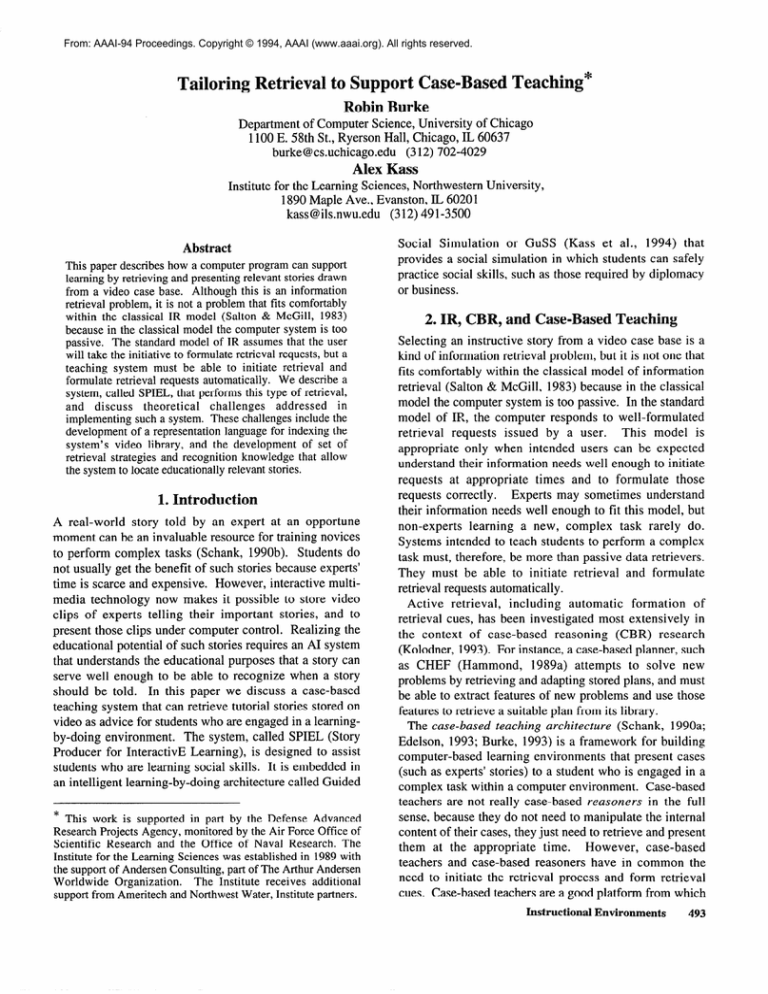
From: AAAI-94 Proceedings. Copyright © 1994, AAAI (www.aaai.org). All rights reserved.
Tailoring Retrieval to Support Case-Based Teaching*
Robin Burke
Department of Computer Science, University of Chicago
1100 E. 58th St., Ryerson Hall, Chicago, IL 60637
burke@cs.uchicago.edu
(3 12) 702-4029
Alex Kass
Institute for the Learning Sciences, Northwestern
1890 Maple Ave., Evanston, IL 60201
kass@ils.nwu.edu
(312) 491-3500
Abstract
This paper describes how a computer program can support
learning by retrieving and presenting relevant stories drawn
from a video case base. Although this is an information
retrieval problem, it is not a problem that fits comfortably
within the classical IR model (Salton & McGill, 1983)
because in the classical model the computer system is too
passive. The standard model of IR assumes that the user
will take the initiative to formulate retrieval requests, but a
teaching system must be able to initiate retrieval and
formulate retrieval requests automatically.
We describe a
system, called SPIEL, that performs this type of retrieval,
and discuss
theoretical
challenges
addressed
in
implementing such a system. These challenges include the
development of a representation language for indexing the
system’s video library, and the development
of set of
retrieval strategies and recognition knowledge that allow
the system to locate educationally relevant stories.
1, Introduction
A real-world
story told by an expert at an opportune
moment can be an invaluable resource for training novices
to perform complex tasks (Schank, 1990b). Students do
not usually get the benefit of such stories because experts’
time is scarce and expensive.
However, interactive multimedia technology now makes it possible to store video
clips of experts telling their important
stories, and to
present those clips under computer control. Realizing the
educational potential of such stories requires an AI system
that understands the educational purposes that a story can
serve well enough to be able to recognize when a story
should be told. In this paper we discuss a case-based
teaching system that can retrieve tutorial stories stored on
video as advice for students who are engaged in a learningThe system, called SPIEL (Story
by-doing environment.
Producer for InteractivE Learning), is designed to assist
students who are learning social skills. It is embedded in
an intelligent learning-by-doing
architecture called Guided
* This work is supported in part by the Defense Advanced
Research Projects Agency, monitored by the Air Force Office of
Scientific Research and the Office of Naval Research. The
Institute for the Learning Sciences was established in 1989 with
the support of Andersen Consulting, part of The Arthur Andersen
The Institute receives additional
Worldwide
Organization.
support from Ameritech and Northwest Water, Institute partners.
University,
Social Simulation
or GuSS (Kass et al., 1994) that
provides a social simulation in which students can safely
practice social skills, such as those required by diplomacy
or business.
, CBR, and Case-
ased Teaching
Selecting an instructive story from a video case base is a
kind of information retrieval problem, but it is not one that
fits comfortably within the classical model of information
retrieval (Salton & McGill, 1983) because in the classical
model the computer system is too passive. In the standard
model of IR, the computer responds to well-formulated
retrieval
requests issued by a user.
This model is
appropriate only when intended users can be expected
understand their information needs well enough to initiate
requests at appropriate
times and to formulate
those
Experts may sometimes understand
requests correctly.
their information needs well enough to fit this model, but
non-experts
learning a new, complex task rarely do.
Systems intended to teach students to perform a complex
task must, therefore, be more than passive data retrievers.
They must be able to initiate retrieval and formulate
retrieval requests automatically.
Active retrieval,
including
automatic
formation
of
retrieval cues, has been investigated most extensively in
the context of case-based
reasoning
(CBR) research
(Kolodner, 1993). For instance, a case-based planner, such
as CHEF (Hammond,
1989a) attempts to solve new
problems by retrieving and adapting stored plans, and must
be able to extract features of new problems and use those
features to retrieve a suitable plan from its library.
The case-based teaching architecture (Schank, 1990a;
Edelson, 1993; Burke, 1993) is a framework for building
computer-based
learning environments
that present cases
(such as experts’ stories) to a student who is engaged in a
complex task within a computer environment.
Case-based
teachers are not really case-based reasoners in the full
sense, because they do not need to manipulate the internal
content of their cases, they just need to retrieve and present
them at the appropriate
time.
However,
case-based
teachers and case-based reasoners have in common the
need to initiate the retrieval process and form retrieval
cues. Case-based teachers are a good platform from which
Instructional Environments
493
to study the retrieval problem because they isolate the
retrieval problem from the other hard CBR problems, such
as evaluation and adaptation.
We claim that the need for precision in educational case
’
retrieval demands a system that understands the uses to
which retrieved material will be put. In other words, just
’
as an effective plan retriever must be based on a theory of
goals and planning, an effective retriever of tutorial cases
must be based on a theory the educational purposes that
’
the retrieved cases can serve. Three types of theories are
need; we will touch on each in this paper.
1. A theory of indexing vocabulary:
a representation
language that can be used to form labels for each story
’
by encoding
the features of story that may prove
important for the system educational purposes.
2. A theory of educational relevance: a taxonomy of the
different kind of points that stories can be used to
make, a theory of the features of stories that are
important for making these kinds of points, and the
features of a student
situation that are appropriateness
conditions for making each kind of point.
3. A theory of opportunity’ recognition: To recognize
storytelling
opportunities,
the tutor must be able to
infer higher-level descriptions of the student
actions
from a stream of low-level event descriptions.
It must
draw reasonable conclusions about what the student is
trying to accomplish, and relate its observations to the
contents of the story base.
3. A Case-Presentation
Instructional Environments
’
Example
The goal of GuSS applications is to accomplish for social
environments
what other simulators
accomplish
for
physical environments,
supporting
learning by doing.
Within GuSS, SPIEL is like an experienced practitioner
watching over the student
shoulder.
It monitors the
simulation and presents stories from its library when they
situation.
The following
are relevant to the student
example illustrates the kind of interaction that SPIEL has
with students using the YELL0 program, in which the
student
task is to try to sell Yellow Pages advertising.
SPIEL has 178 stories told by account executives with
great experience
in selling.
Consider
the following
interaction in which one of these stories is retrieved:
Student:
So, we
going to go ahead with the 114 page
ad with color?
Customer:
OK.
Student:
Just sign right here.
C.;Z.er:
[signs]
..
I think the color is really going to attract
people to your ad.
Customer:
I sure like the way it looks.
Student:
Ask your customers what they think. I bet
you find its an attention-getter.
Customer:
See you next year.
Student:
See you. [leaves]
494
This is a sales success, but SPIEL has a cautionary story
to tell. Every moment the student remains after the close
of the sale gives the customer an opportunity to retract his
buying decision. Although that did not happen here, it is a
possibility that the student should be aware of.
SPIEL intervenes by first signaling to the student that it
has a story available.
Then, if the student expresses an
interest in hearing the story, it explains why the story is
relevant,
shows a video in which an experienced
salesperson relates the story as a personal experience, and
finally sums up the main point of that story as it applies in
the current situation (see Figure 1):
Figure 1. Examnle of storv presentation
window
Headline: A story showing
the risks of your
approach. . .
Bridge: You kept talking to the client after the sale
was closed.
Nothing bad happened but here
a
story in which doing that led to problems:
Video: I was in the South BendMishawaka
area.
This was my first or second year. I was calling on
a swimming pool contractor, He had a quarter page
in South Bend. I was proposing a quarter page in
another directory. It was sitting at his kitchen table.
And the guy was hesitating; he didn know... So,
after a few more attempts, he says to me “
I
go with the other quarter page.
He bought it. I
pushed the order form in front of him. He signed it.
It done.
As I’m putting my stuff together, I made this
comment that cost me the quarter page. I said, as
I’m packing up, “I’m sure that you’re going to get a
lot of phone calls from that new ad.” He looked at
me and he said, “You know, I don’t need any more
phone calls. 1’11tell you what, let’s not do that this
year, maybe next.” I talked myself out of a quarter
page. I’ve never done it since. I walked out. There
was nothing I could say. I had it and I lost it. All I
had to say was “Thank you very much Joe. See you
next year.” But I didn’t. I had to tell him about the
calls, which I’d already done twenty times. 1
Coda: Nothing bad happened to you because you
kept talking to the client after the sale was closed,
but sometimes the client changes his mind.
In this example, the storyteller augments the student’s
simulated experience in an important way. Without the
“Talked myself out of a sale” story, the student, who was
successful,
might never realize the risks inherent in
remaining after the sale. The story arrives just at the time
when it is most relevant, after the risk is past and the
student thinks all went well, and it is exactly on point as a
counterexample:
it shows a situation in which the same
tactic had an opposite outcome.
The retrieval phase of SPIEL is implemented by a rulebased system that interfaces
with the GuSS learning
environment.
The rules created during the storage phase
are matched against on-going events in the simulated
world, as the student takes actions and the simulated
characters
respond.
Successful
recognition
of an
opportunity causes a story and its associated strategy to be
retrieved.
The rest of this paper discusses some of the
details of the implementation
of SPIEL’s retrieval
architecture,
starting with the indices for stories.
For
brevity, we have omitted the discussion of SPIEL’s simple
natural language generation.
----------T--B-
Retrieval
3.1. How the system works
SPIEL operates in storage and retrieval phases.
The
The
storage phase prepares the system for storytelling.
storyteller examines its stories in the light of its set of
storytelling
strategies, its library of different ways that
stories can be used to teach, and determines what kinds of
situations could arise that would constitute opportunities to
tell each story. In the retrieval phase, the system tries to
recognize those opportunities as the student is performing
the task.
This design is similar to approaches
to
“opportunistic
memory”
architectures
proposed
for
opportunistic planning (Hammond, 1989b). A schematic
picture of the phases is shown in Figure 2.
The storage phase begins with the manual construction of
indices. An indexer watches the story on video and uses
an indexing tool to construct labels representing what it is
about.
Indices are then processed
using storytelling
strategies, representations
of the tutorial purposes stories
can serve. SPIEL determines,
for each combination
of
story and strategy, how and when it might tell the story
using the strategy, thus characterizing
the storytelling
opportunities
that the story affords. The rule generator
converts
descriptions
of these opportunities
into
procedures for recognizing them, in the form of rules that
are compatible with the learning-by-doing
environment.
’ SPIEL’s stories are video clips from videotaped interviews
with experienced Yellow Pages account executives.
The
surrounding explanations are generated by the program.
Story with bridge and coda
Figure 2. How SPIEL works
ndexing stories
In traditional IR, indices are keywords. The meaning of a
document is approximated from words found in the text.
Because SPIEL’s stories are in video form, text ceases to
become a “cheap feature.”
Indices must be entered
manually.
SPIEL makes use of structured indices that are
more precise representations of the story’s point or points.
The points of SPIEL’s first-person
anecdotes
often
comes from an expectation violation, a event that surprises
the narrator or someone else in the story (Schank, 1982;
Schank et al., 1990). In the “Talked myself out of a sale”
story, the salesperson is surprised to find his attempt at
reassuring the customer backfires into a loss of the sale.
These anomalies make the stories interesting and they are
also the key to the stories’ relevance
in educational
situations.
An indexing representation
for such stories
must therefore a language for expressing anomalies.
The
general form of an anomaly can be stated as follows:
Actor X had an expectation that Y would happen,
but actually Z happened.
A statement of the anomaly from the “Talked myself out
of a sale” story is
Instructional Environments
495
The salesperson wanted to reassure the client about
his purchase but actually the salesperson lost the
sale.
This anomaly captures one important aspect of what the
story is about. A story usually says (or implies) more than
this, including why the expectation came about and why it
failed.
The salesperson
obviously thought that talking
about the increased number of calls the client would get
would be reassuring, and thought that reassuring the client
was an important goal. The expectation failed because the
time spent after the sale gave the customer time to
reconsider,
Figure 3 is an outline of the “Talked myself
out of a sale” index.
The index contains the anomaly
(shown in bold) and the explanation of the anomaly. The
anomaly highlights the feature that is different between the
hoped-for case and the actual case.
Viewer:
Perspective:
Agent:
Goal:
r
Plan:
Result:
Neg. side-eff.
customer not
confident
Figure 3. Index for “Talked mvself out of a sale.”
5. Determining
relevance
SPIEL’s ability to tailor its retrieval
to the task of
education
comes from its storytelling
strategies,
its
knowledge of the conditions
under which a story with
particular characteristics
will be relevant to a student. In
the example above, the “Talked myself out of a sale” story
was told using the Demonstrate
risks strategy.
This
strategy selects stories about the failure of a particular
course of action and tells them when the student has
executed a similar course of action but had success. The
story is relevant because it contradicts the evidence of the
simulation
with respect to the student’s recent success.
This is an educationally-appropriate
way to intervene
since, without the story, the student might not see the risks
identified in the story.
5.1. SPIEL’s storytelling strategies
There are two main sources of relevance for stories in a
learning-by-doing
environment:
(1) they can point out
errors that the student
may be making
when the
environment
does not provide sufficient feedback for the
student,
and (2) they can help the student explain
expectation failures when the environment
does not give
all the information
needed to construct an explanation.
496
Instructional Environments
SPIEL has thirteen storytelling strategies, which fall into
four categories based on their relationship
between the
stories they present and the situations
in which they
present them. The strategies are described in detail in
(Burke, 1993).
Strategies that show the student alternatives. These
strategies
present
stories
whose
outcomes
differ
substantially
from what the student has achieved in the
simulated world. Demonstrate risks falls in this category.
Confronting
students
with stories about alternative
possibilities gets them to question their expectations about
the simulated world.
Strategies that critique the student’s expectations.
By showing examples of situations where people in a
similar role had preconceptions
that were incorrect, these
strategies help students transfer expectations
from their
everyday social lives to the specialized social environment
they are learning about.
Strategies that project possible results of actions the
student is taking. Normally, students receive immediate
feedback from the execution of their plans. If they do not
get such feedback,
projection
strategies
call for the
storyteller
to provide
examples
that show possible
outcomes.
Strategies that explain the perspectives
of other
people to the student. These strategies recall stories that
explain why people acted as they did in real world
situations, making the unexpected actions of others in the
simulation comprehensible.
These categories cover the most important ways that
stories can be relevant to students using GuSS.
They
concentrate especially on plans and outcomes, which is
consonant with the emphasis in GuSS on learning-bydoing. Students are largely engaged in planning and acting
in the social environment.
In a different kind of task, such
as a design task, students would focus on different kinds of
expectations,
such as how a design feature achieves a
given function and how it will interact with other features.
The case-based teaching system Creanimate
(Edelson,
1993) has retrieval
strategies
organized
around the
problem of design.
5.2. Demonstrate risks: A storytelling strategy
Whenever
one confronts
a complex
problem,
it is
important to know the range of possible outcomes: What is
the best and worst that could happen? Both in real life and
in GuSS’s simulator,
the student gets to see only one
outcome
at a time.
Stories that show a range of
alternatives
provide necessary
balance.
Alternativefinding storytelling strategies are designed to bring to the
student’s attention stories that differ in significant ways
from the student’s experience’in the simulated world.
The idea behind Demonstrate
risks is to tell a story
about a failure when the student has experienced success.
One reason this is important
is that no simulation
is
perfect. If the simulation is not accurately reproducing the
circumstances encountered in the story, the story points out
possible differences between the simulation and the real
The example in section 2.1 shows
world of practice.
Demonstrate risks in action in YELLO. In general, this
strategy needs to see that the student is in a situation
similar to that in the story, but has achieved an outcome
that is very different: the student has succeeded where the
The strategy calls on SPIEL to
story shows a failure.
predict an outcome that would be “very different” from
losing the sale, different enough that it makes sense to tell
Such opposite-finding
the story as an alternative.
inference occurs in each alternative-finding
strategy.
An opposite outcome is not something that contradicts
the original in every respect. It does not make sense to say
that the opposite of achieving X is failing to achieve Y,
where X and Y are opposite goals. If anything, these
would be similar outcomes.
An opposite result is an
opposite impact on the same goal.
This is a simple
example,
but more complex
cases of the opposite
computation,
such as that in the strategy Demonstrate
alternative plan, where an opposite plan must be found,
require involved opposite-finding
inference. The details of
the opposite-finding
algorithm
and other inference
mechanisms in SPIEL can be found in (Burke, 1993).
6. Implementing
l
recognition
Indices represent
what a story is about.
Strategies
represent how, in general, stories can be made relevant to a
student.
There is one final link that a storytelling tutor
must make, which is the connection
between students’
actions and its notion of a relevant story. As shown in the
examples,
this involves
a variety of considerations
including
social knowledge,
such as the scope of a
conversation, and practical details that are a function of the
simulation environment itself.
The tutor needs a general understanding
of the task: that
selling involves
sub-goals
like gathering
information,
constructing
presentations,
making sales pitches, and
answering objections, for example.
At a more concrete
level, SPIEL has to know particular details of how the
selling task is achieved by the student in the YELL0
application.
It has to know which kinds of answers from a
customer constitute substantive information and which are
evasions, what actions constitute the construction
of a
prospective
ad, and so forth.
SPIEL is operating in a
environment
with limited scope. It does not have to be
concerned about every possible way a student can ask a
question; it need only recognize those choices that GuSS
actually permits.
6.1. Applying storytelling strategies
How would an opportunity to tell the “Talked myself out
of a sale” story be recognized by SPIEL? The tutor would
look for (1) the student to successfully complete the close
of a sale, but (2) remain to talk with the customer, and then
(3) finish the sales call without losing the sale. Then it
would (4) tell the “Talked myself out of a sale” story to
point out the possibly risky tactic the student had used..
We call the sequence of conditions for recognizing
a
storytelling
opportunity
a recognition
condition
description or RCD. The RCD describes what situation
the student would have to encounter for the story to be
relevant.
Recognition condition descriptions
have three
parts: (1) a context in which the story would be worth
telling, (2) conditions that indicate that the story is relevant
in that context, and (3) the story itself and the manner in
which it should be presented.
These three parts can be
thought of as filling roles in the following abstract rule
form:
When trigger, Look for evidence, Then presentation.
To create the RCD, a storytelling strategy must reason
about how concepts in the index or those inferred from the
index may be manifested
in observable
actions in the
simulation.
SPIEL has a library of manifestation
rules
designed to predict characteristic actions that correspond to
internal states.
For an example, the RCD generated for the story “Talked
myself out of a sale” when told using the Demonstrate
risks strategy looks like this:
WHEN the student is in the closing stage of the sales call
and talking to the buyer,
LOOK FOR the student to make the sale, continue
conversing with the customer, and not to lose the sale,
THEN TELL “Talked myself out of a sale” AS a
“Demonstrate risks” story.
6.2. From description to mechanism
Creation of the trigger and evidence conditions completes
the construction
of an RCD. The RCD represents the
recognition conditions for a tutorial opportunity describing
a good time to tell a particular story using a particular
strategy. The next part of the storage-time processing of
SPIEL is rule generation, the construction of procedures
capable of recognizing storytelling opportunities.
The GuSS simulation is organized around a production
system interpreter.
Each of the characters in the social
simulation is implemented
by a production system, like
those found in expert systems. To fit into this environment
most effectively, the retrieval-time component of SPIEL is
also implemented as a production system. The task of the
rule generation
component
of SPIEL is to produce
production
rules capable of recognizing
the tutorial
Instructional Environments
497
opportunities
that have been created
by applying
storytelling strategies to indices.
The first step in rule generation
is to make the
recognition conditions concrete, to reason about how these
conditions might arise and describe their occurrence in
terms of actions that the student might actually take. To
perform this elaboration,
SPIEL needs knowledge about
observability
in the simulated world. It must know what
kinds of actions are and are not available to the student and
The output of this step is an
the simulated
agents.
expanded
RCD (or eRCD)
representing
the same
recognition conditions as the original RCD, but placing
them in terms of their concrete, observable manifestations.
From the expanded RCD, the system designs a set of
rules that will recognize the situation it describes.
The
initial stage of rule design is the construction
of a rule
specification, a directed graph indicating what production
rules are needed and how they will relate to each other.
Each node in the graph is a rule that the generator needs to
produce.
The triggering conditions are implemented
by
two rules, one that looks for the individual who is the
buyer, and one that looks for the student to begin the
closing stage of the sales process. If the student gets the
sale but then leaves immediately, the story is not relevant.
So there is a deactivating rule that halts recognition in this
case. There is a second deactivating rule that comes in if
the customer does what the customer does in the story,
rethink the buying decision. In this case, the student does
not need to see the story because the simulation has amply
demonstrated the folly of remaining after the sale.
In the final rule specification graph, each node contains a
condition or set of conditions
that a rule will have to
recognize.
Rules are produced by walking through this
graph translating
from the descriptions
into simulation
states that rules can directly test for. For example, a
“customer signing contract” condition becomes a test for a
signing event with the actor and object slots bound to
certain values.
7. Current Status
Formative
evaluation
of an earlier version YELL0
containing a subset of SPIEL’s stories was performed using
Yellow Pages account executives as subjects. We found
that users reacted well to the stories, finding SPIEL’s
interventions
interesting and relevant. (Kass, et al. 1994)
describes some of these findings.
SPIEL is currently being adapted to teach personnel
management.
The most significant
drawback in this
conversion
is the need for a large knowledge base of
domain knowledge in order to apply storytelling strategies.
This knowledge
does not transfer from one domain to
another and its acquisition forms a significant bottleneck
for developing storytelling programs based on SPIEL. We
498
Instructional
Environments
are beginning to address this problem using knowledgeacquisition
techniques
to build an interactive
tool that
draws on the user’s domain knowledge
when applying
storytelling strategies.
8. Conclusion
Currently users only benefit from on-line databases when
(a) they realize they have an information need, and (b) they
know how to formulate retrieval queries. We feel there is
much greater potential inherent in on-line databases, such
as the video case-base discussed in this paper. However,
realizing that potential requires intelligent systems that can
initiate retrieval, formulating their own retrieval requests,
not just responding to retrieval requests from a user.
In building such a system, we have moved away from
generic information
retrieval: we found that what was
required was a careful analysis of the purposes that
retrieved information will serve. Such an analysis makes it
possible to create retrieval systems like SPIEL that tailor
retrieval by actively reasoning about those purposes.
References
Burke, R. D. 1993. Representation,
Storage and Retrieval
of Tutorial Stories in a Social Simulation. PhD Thesis,
Northwestern University.
Edelson, D. C. 1993. Learning from Stories: Indexing,
Reminding and Questioning
in a Case-based Teaching
System. PhD Thesis, Northwestern University.
Hammond,
K. J. 1989a. Case-based planning. Boston:
Academic Press.
Hammond,
K. J. 1989b. Opportunistic
Memory.
In
Proceedings
of the Eleventh
International
Joint
Conference on Artificial Intelligence,
504-S 10. Menlo
Park, CA: International
Joint Conferences on Artificial
Intelligence, Inc.
Kass, A., R. Burke, E. Blevis, and M. Williamson
1994.
Constructing learning environments
for complex social
skills. Journal of the Learning Sciences. Forthcoming.
Kolodner, J. L. 1993. Case-based reasoning. San Mateo,
CA: Morgan Kaufmann.
Salton, 6., and M. J. McGill 1983. Introduction to modern
information retrieval. New York: McGraw-Hill.
Schank, R. C. 1982. Dynamic Memory: A Theory of
Learning
in Computers
and People.
Cambridge
University Press.
Schank, R. C. 1990a. Teaching Architectures,
Technical
Report, #3. Institute for the Learning Sciences.
Schank, R. C. 1990b. Tell Me a Story: A New Look at Real
and Artificial Memory. New York: Charles Scribners
Sons.
Schank, R. C., R. Osgood, M. Brand, R. Burke, E.
Domeshek, D. Edelson, W. Ferguson, M. Freed, M.
Jona, B. Krulwich, E. Ohmaye, and L. Pryor 1990. A
Content Theory of Memory Indexing, Technical Report,
#2. Institute for the Learning Sciences.


